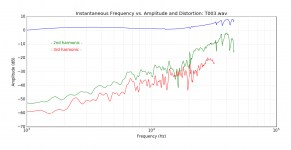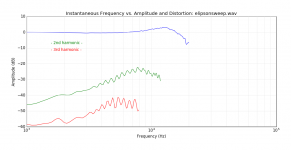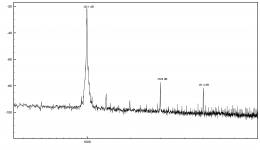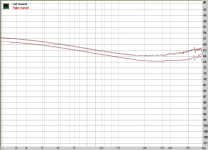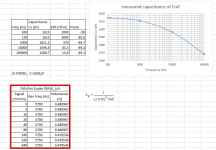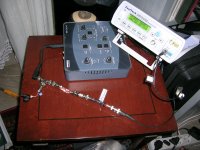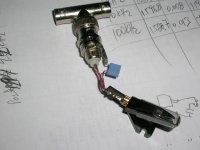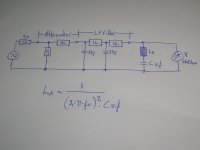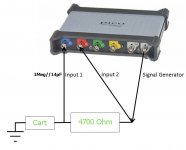This is where I am on the plot routine, there are a couple of details (as always) I need to note. Thanks for your inputs.
Attachments
This is where I am on the plot routine, there are a couple of details (as always) I need to note. Thanks for your inputs.
Very nice indeed. I have a sweep from my Elipson test record uploaded and it would be interesting to see how the distortion looks like with this record and cartridge (Shure V15V/JICO).
Now this is only 25 Hz - 20 kHz and the cart drops above 17 kHz with this loading so it may be less interesting for the topic of performance of cartridge in the ultrasonic region.
Dropbox - Elipson sweep.wav - Simplify your life
Now this is only 25 Hz - 20 kHz and the cart drops above 17 kHz with this loading so it may be less interesting for the topic of performance of cartridge in the ultrasonic region.
Pretty nice performance (left channel shown) the sweep is a lot cleaner than most. The sweep looks like ~40sec/decade so the ripples in the THD appear equally spaced and at the rotational frequency. This is interesting the other plots have noise that might mask this. I have a lot of errands to run today I might compare channels later.
BTW we have been concentrating on resonances and other high frequency misbehavior so the plots are still only ~1kHz and up, not much of interest below that.
Attachments
Thanks for this. There are two sweeps on this record, one faster and one slower sweep. This is the slower sweep. One could examine the ripples of the faster sweep to get some clues.
Should also add that this is a mono sweep both channels. Meaning that crosstalk may add to 2nd harmonic together with lateral tracking distortion (which is different depending on the position of the sweep on the record). Except for the Ortofon I don't have any records with separate sweeps for R and L.
Another thing: this is the Moerch UP-4 Unipivot arm. I am not 100 % sure if any instability of the unipivot design may show up in the distortion plots, e.g by slowly tilting azimuth with rotation. I would like the dual pivot DP-6 or DP-8 to compare with but getting any of these is a bit difficult for various reasons. Optimally I would also like to get the Moerch Concorde arm for my OM40 as well, but these are very rare to find.
Another thing: this is the Moerch UP-4 Unipivot arm. I am not 100 % sure if any instability of the unipivot design may show up in the distortion plots, e.g by slowly tilting azimuth with rotation. I would like the dual pivot DP-6 or DP-8 to compare with but getting any of these is a bit difficult for various reasons. Optimally I would also like to get the Moerch Concorde arm for my OM40 as well, but these are very rare to find.
Last edited:
For comparison I show a plot from the same record but FFT averaged of a 1000 Hz signal. The distortion components looks lower, especially for the 2nd harmonic.
Last edited:
JP,I can, but it'd be this upcoming weekend as we spend weekend and weekdays in separate locations; different computers.
Thanks for sending the 33rpm recording.
This gives me the right information to ask Ortofon what their intention was with this sweep track.
I took your 45rpm recording from 2kHz to 50kHz and compared it to your 33rpm recording from 1.5kHz to 37kHz and combined them in one image.
They should be perfectly parallel with 2.6dB in level between them because of the 1.35 higher speed.
This is roughly the case to within +/-1dB.
You can also see a few anomalies with both speeds shortly before the high end, which can only mean that they are record related.
Your Cart is really a perfect measuring instrument and I don't understand why Technics stopped to producing this excellent product.
Hans
Attachments
The image:
I noticed that the distortion on the right channel was lower. I also removed everything but a small slot around from a section centered on the second harmonic and you can see the AM of the seconds at .55Hz fairly clearly.
I haven't chimed in with one of my legendary dumb questions recently so here goes 🙂
Have we worked out yet how to extract the fundamental test record distortion from the cartridge distortion? I'm assuming on a spin down test of a fixed frequency we would see a knee in the distortion curve IF cart distortion ever became lower than cutting head?
Have we worked out yet how to extract the fundamental test record distortion from the cartridge distortion? I'm assuming on a spin down test of a fixed frequency we would see a knee in the distortion curve IF cart distortion ever became lower than cutting head?
Optimally I would also like to get the Moerch Concorde arm for my OM40 as well, but these are very rare to find.
Only discovered these on a thread on VE a couple of days ago. MC200 and concord MM version are out there and beautiful. I'll continue to slum it with my SME 30H, but would love one if I had the money.
I'm assuming on a spin down test of a fixed frequency we would see a knee in the distortion curve IF cart distortion ever became lower than cutting head?
Except using a groove with constant geometry with respect to the stylus would only reveal second order effects (I think) due to groove velocity etc.
Below 2 images , one with Level going up from 4.5mVeff to 450mVeff
Hi Hans
I run a test for inductance change vs signal level on the L channel of Bill’s Super OM10 using the resonance method. I don’t find any change, only a slight drop at very high signal levels.
The second and most important discrepancy when comparing your measurements on Super OM10 and mine is that I find the self resonance occurring at around 70kHz no matter how I test it, while your measurements show it at 40kHz.
What do you think can cause that much difference?
George
Attachments
I noticed that the distortion on the right channel was lower. I also removed everything but a small slot around from a section centered on the second harmonic and you can see the AM of the seconds at .55Hz fairly clearly.
I think there is a wavy pattern in the fr response also in my previous graph with the Elipson (but not the Ortofon) post #1112.
What I still don't understand is the ≈ -46 dB 2nd harmonic @1000 Hz from your algorithm compared the ≈ -56 dB that I get, so I will look further into this. Third harmonic is about the same though.
Only discovered these on a thread on VE a couple of days ago. MC200 and concord MM version are out there and beautiful. I'll continue to slum it with my SME 30H, but would love one if I had the money.
Yes I saw it mentioned at Audio Asylum many years ago but I have not seen any picture of that one. So it is probably extremely rare.
Hi George,Hi Hans
I run a test for inductance change vs signal level on the L channel of Bill’s Super OM10 using the resonance method. I don’t find any change, only a slight drop at very high signal levels.
The second and most important discrepancy when comparing your measurements on Super OM10 and mine is that I find the self resonance occurring at around 70kHz no matter how I test it, while your measurements show it at 40kHz.
What do you think can cause that much difference?
George
Good to know what these differences may cause.
To start with Fres.
My test gear has an 1Meg//14pF input, see image below.
After having made the run from 100Hz to 1MHz, I have imitated the same magnitude and phase with LTspice still with 1Meg//14pF, thereby being able to modelling the replacement circuit.
Once LTSpice and my measurement where 100% identical, I removed the 1Meg//14pF and made the final run resulting in the picture below, showing an Fres = 53kHz.
Hans
Attachments
- Status
- Not open for further replies.
- Home
- Source & Line
- Analogue Source
- Cartridge dynamic behaviour
